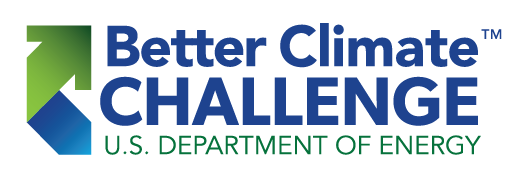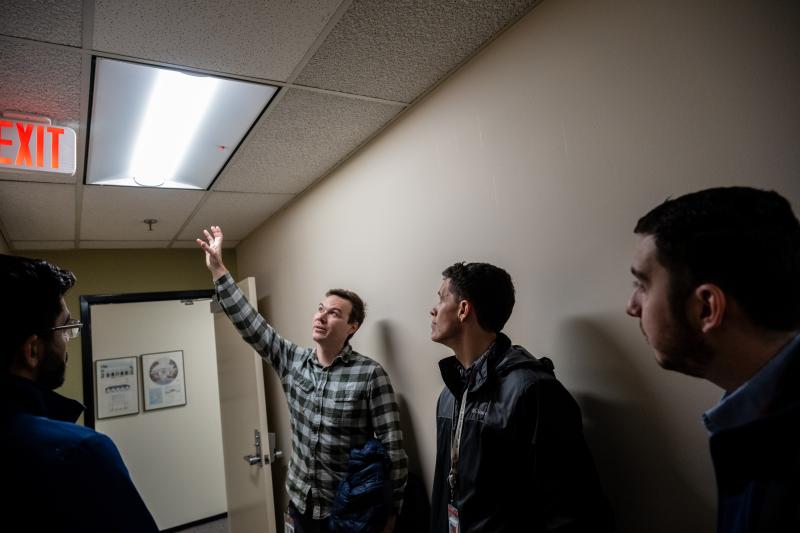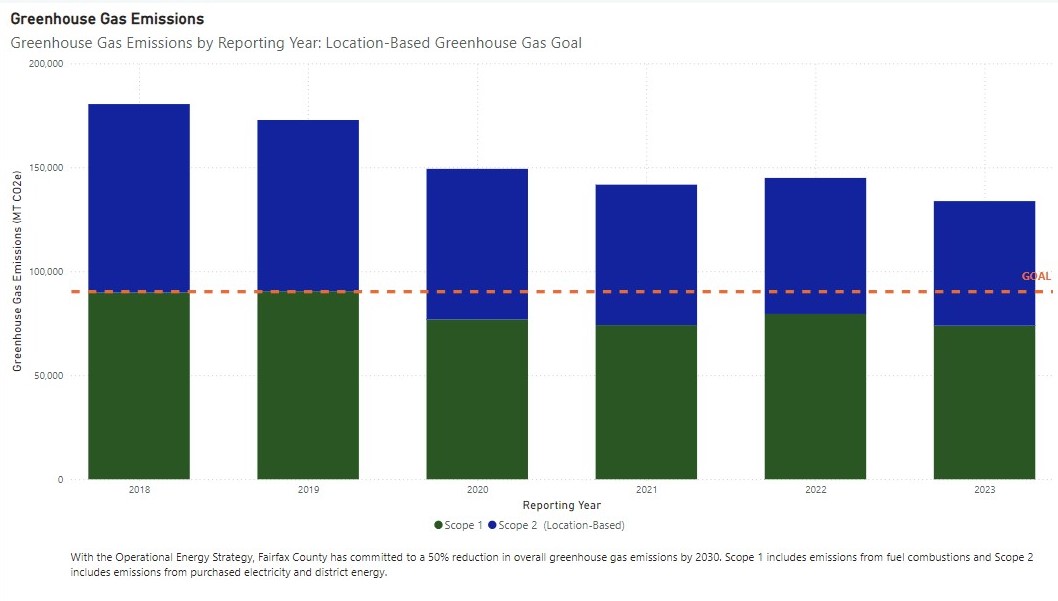Post written by Kevin Smith, Division Manager, OEEC
Fairfax County Government has ambitious goals to reduce its greenhouse gas emissions, including becoming carbon-neutral by 2040. Reaching that goal will require a sustained, multi-pronged effort to reduce fossil fuel use in county facilities and operations. Fortunately, programs like the U.S. Department of Energy’s Better Climate Challenge are helping Fairfax County and other jurisdictions across the country make progress toward those goals by sharing innovative solutions, offering technical assistance, and providing peer-to-peer learning opportunities.

What is the Better Climate Challenge (BCC)?
The U.S. Department of Energy’s (DOE) Better Climate Challenge is a program that encourages organizations to partner with the DOE for support in their efforts to reduce their greenhouse gas emissions – sometimes referred to as decarbonization.
Through BCC, not only can partners leverage technical expertise from DOE, but they also join a network of market leaders with access to peer-to-peer exchange opportunities. Partners can range from local governments to school districts and higher education campuses, to private companies in the manufacturing and data center spaces, and more.
Fairfax County Government joined BCC in 2022 and in doing so, pledged to reduce its greenhouse gas emissions by 50% within 10 years, using Fiscal Year (FY) 2018 as a baseline. The BCC commitment aligns with the county’s Operational Energy Strategy (OES), which has an interim target of 50% greenhouse gas emissions reduction by FY 2030.

How are greenhouse gas emissions tracked and reported?
Fairfax County calculates its greenhouse gas emissions on an annual, fiscal year basis and reports to the DOE by August 1st. While the county joined BCC in 2022, the baseline year for assessing progress is FY2018, which aligns with the baseline year for OES.
This calculation process starts with compiling information from two sources:
- electricity and natural gas consumption in the county’s building portfolio from utility bills; and
- vehicle fuel consumption from the county’s vehicle and transit fleets using the county’s fuel management software.
Next, greenhouse gas emissions factors are applied to energy consumption to find the annual emissions from each source. Emissions factors for our regional electric grid, natural gas stationary combustion, and vehicle fuel combustion are sourced from the U.S. Environmental Protection Agency’s Greenhouse Gas Emission Factors Hub.
Finally, the three annual emissions values (building electricity, building natural gas, and vehicle fuel), in pounds or tons of CO2-equivalent, are summed to find the total emissions for county government operations. However, the county acquires renewable energy credits (RECs) as an alternative method to reducing greenhouse gas emissions as renewable energy projects ramp up. Once electricity emissions are calculated, any acquired RECs are applied appropriately to determine the net emissions.
Greenhouse gas emissions are reported for Scope 1 (direct on-site energy combustion: natural gas and vehicle fuel) and Scope 2 (indirect off-site power generation: electricity) emissions.

What kind of support does the DOE offer to BCC partners?
The DOE offers several avenues for support for partners in their efforts to meet the emissions reduction goal.
Fairfax County meets with the BCC team quarterly for technical assistance calls. During those meetings, Fairfax County and BCC discuss the county’s decarbonization efforts, whether it is a review of annual emissions data, review of current decarbonization efforts, or discussion of upcoming BCC events and learning opportunities.
Additionally, the DOE leads BCC technical working groups devoted to topics such electrification, onsite renewable energy, and shifting to low-impact refrigerants. During the meetings, which take place over a period of six months, partners discuss their experiences with the given topic, including lessons learned, challenges, and success stories. At the end of the working group cycle, the DOE team assembles notes and feedback to develop technical frameworks and other helpful documents that anyone around the world can utilize in their decarbonization efforts.
A third form of support is through organizing technical conferences and webinars. The flagship event is the DOE’s Better Buildings, Better Plants Summit held annually in the spring in Washington, D.C. In the 2024 edition of the Summit, I represented Fairfax County and OEEC on panels which focused on external stakeholder engagement for decarbonization, and on vehicle fleet electrification. This was a great opportunity to connect with leaders across the country and share feedback and challenges in our decarbonization journeys.
Is Fairfax County on track to meet the BCC commitment?
In FY 2023, Fairfax County achieved a 26% reduction in greenhouse gas emissions from government operations compared to the FY 2018 baseline. Some of that decrease – roughly 9% – is attributed to the greening of our electric grid. The remaining 17% is due to efficiency and conservation efforts in our buildings and fleet vehicles.

In existing buildings, we’ve replaced older fluorescent and other inefficient lights with LEDs, and replaced aging heating, ventilating and air-conditioning (HVAC) equipment and controls with modern, more efficient alternatives. Where possible, we’ve implemented whole building energy retrofits, including award-winning projects at the Department of Housing and Community Development’s Pender Building and Fairfax County Park Authority’s Cub Run Rec Center.
Beyond energy efficiency upgrades, the county has started installing solar photovoltaic (PV) systems on county buildings. The first solar PVs were installed on the rooftops of Reston Fire Station and Woodlawn Fire Station in summer 2023. As November 2024, solar PV systems have been completed at 10 sites with a total capacity of 1.2 megawatt (MW), enough to power about 110 homes.
Fuel consumption decreased by about 18% from FY 2018 to FY 2023. This is due in part to replacing older fleet vehicles with more fuel-efficient modern options, including hybrids and electric vehicles (EVs). The vehicle fleet now has 55 EVs and 12 battery-electric buses in service, in addition to 378 hybrid light-duty vehicles and 5 hybrid diesel-electric buses. Fairfax County’s departments of Vehicle Services and Transportation also use telemetry systems to track vehicle miles traveled and are continuously looking for more effective and efficient routes and usage patterns.
Although we have a ways to go to reach our climate goals, the consistent decrease in emissions is an indication that the county’s energy policy is truly being operationalized.
Learn more about what Fairfax County is doing to decarbonize its operations:
Our efforts to meet our Better Climate Challenge policy are driven by the targets, goals, and strategies contained in the Operational Energy Strategy. Visit our Operational Energy Strategy webpage to learn more about county energy policy; see what we are doing to decarbonize our buildings, electricity supply and vehicle fleet; and track progress toward our goals.

Kevin Smith has been with OEEC since 2022 serving as the division manager for energy programs, leading the implementation of the county’s Operational Energy Strategy. He is a licensed mechanical engineer with over a decade of experience in building design & construction, and facilities optimization.
Climate Matters is the blog of Fairfax County’s Office of Environmental and Energy Coordination, where we share stories, insights and information related to climate change and environmental sustainability. Posts are written by knowledgeable and passionate OEEC staff members and guest authors. To read all blog posts, visit Climate Matters.

